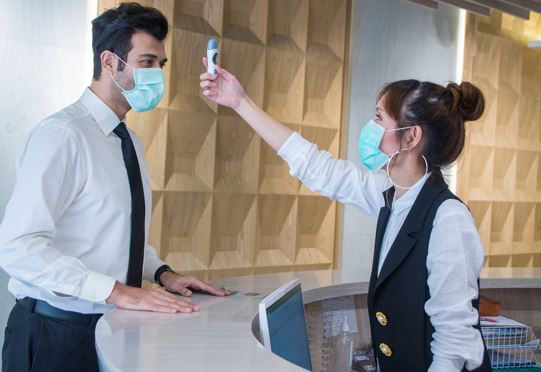These are some of the most challenging times that we’ve been experiencing since the beginning of this year. From the major disruptions faced by the businesses worldwide, to the ways we socialize and engage with others; life has changed as we know it. Even after eight months of lockdown and social distancing, one can feel the uncertainty and uncomfortability thick in the air as many countries are slowly easing off restrictions and businesses preparing to callback employees to the offices. For places that are still in partial or complete lockdown, the reopening of workplaces is inevitable as a future event, sooner than later. This leads to the highly-debated, meaningful question – can employers provide safe and healthy offices to limit contamination?
The new normal is many things, but not anything that we’ve known previously. There’s no going back to the same idea of workplaces as we left them when we took refuge into our homes early February. When asked, a majority (60%) of workers showed interest in working from home because of health safety concerns. Therefore, employers need to instigate new safety standards, protocols, and measures to rebuild their employees’ trust and confidence into returning to work. It is a daunting task to adapt, execute, and streamline the newer operations, and it would require time and agility until the balance is met by the enterprises.
Trends show that workers have been terming it the ‘death of shared spaces’ as they would want to socially distance themselves from fellow workers once they rejoin. Reception centres and coffee machines may get replaced with temperature check kiosks equipped with hand sanitizer, face masks, and personal hygiene booths. For most enterprises office routines can get more event or training-based preference where employees would only be required to be present in case of innovative and creative sessions, as remote work takes care of the other routines. No matter what the scenario, enforcing the following steps may help you to monitor and be double sure of every little detail that goes on to ensure the health and productivity of your employees:
1. Temperature Monitoring and Tracking
Easier said than done, companies need to come up with a robust and round-the-clock system of taking temperature checks, spotting symptomatic workers, issuing isolation, as well as contact tracing for analyzing the people they’ve come in contact with recently. Regular health updates, public health guidelines can also be shared with respective employees in the daily newsletter, emails.
2. Thorough Risk Assessment
It only seems fitting for businesses to conduct a COVID-19 risk assessment and re-analyze their risks before they look forward to employees coming back to the offices. It may help in putting things into perspective for the employers as it can give deep insights into the required control measures, learn about the impact on your processes, and look for the right solutions.
3. Follow Official Guidance
Majority of the governments across the world have published sector-specific guidelines that can help your workplace to become ‘COVID-19 proof’. As an employer, all your workplace protocols and measures need to follow the same pursuit and take from open-source portals like WHO, CDC, and more for advice on sanitizing and cleaning up systems.
4. Impact-based Risk management for employees
Unlike previous times, you cannot look after all your employees under a ‘one size fits all’ system once they get back to the office. Since each of the employees come from different scenarios – as some can be parents, while others may have underlying mental health issues; as an employer you need to cater to each one’s health safety accordingly. Starting from the employees at the higher risk, you also need to keep a closer look on maintaining equality in recognizing their health safety protocols in your offices.
5. Transparent Cleaning, Health Safety Procedures
The COVID-19 induced lockdown has affected everyone’s minds one way or the other; and therefore instilling confidence into office spaces may take time, but the enterprise needs to ensure that it’s a transparent process. They can discuss with their employees about the cleaning, health, and safety protocols to keep them engaged and feel heard at the same time. Enterprises can also publish about the processes involved in details on their websites, and other digital platforms for making workers feel more comfortable.
6. Work on Remote whenever possible
Encouraging remote work can make your organization more pandemic-proof. Furthermore, it also keeps your employees safe and closer to home, thus being more at ease with their work. Unlike the initial months of remote working for beginners, after all these months your employees may have gotten better, and even aced the remote working setup. For better connectivity, you need to ensure:
- Your remote workers are looked after for any technical/IT requirements
- They have solid communication channels with their team
- Their mental and physical well-being
- If they’re as involved as the employees at your office.
Bottomline
One thing that has surfaced in these uncertain times of the pandemic, is how vital role technology plays in getting workplaces evolved and becoming better equipped to handle such overwhelming issues. As offices reopen, the changes may not just be seen in the ground rules, but also in the HR management and the ways of execution of any protocol. Check out online stores like Paragon tools to stock up on masks and sanitizer for your office.
However, we need to keep in mind that the response of the COVID-19 pandemic in terms of workplace settings is continuously evolving, and companies that can leverage the most of the learning curve are going to stay ahead of others. In case you’re looking for a safe and fully operational coworking space in Kolkata, Zioks can be a great place to get your work started. You can also learn all about coworking and if it’s right for you in their blog.

